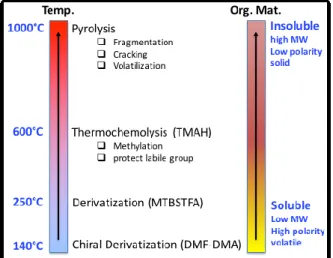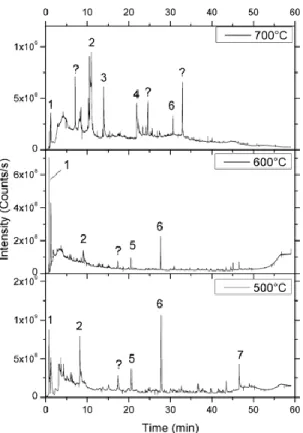HAL Id: insu-01285239
https://hal-insu.archives-ouvertes.fr/insu-01285239
Submitted on 9 Mar 2016
HAL is a multi-disciplinary open access
archive for the deposit and dissemination of
sci-entific research documents, whether they are
pub-lished or not. The documents may come from
teaching and research institutions in France or
abroad, or from public or private research centers.
L’archive ouverte pluridisciplinaire HAL, est
destinée au dépôt et à la diffusion de documents
scientifiques de niveau recherche, publiés ou non,
émanant des établissements d’enseignement et de
recherche français ou étrangers, des laboratoires
publics ou privés.
Search for Organic Material on Mars with the
Thermochemolysis Derivatization Technique Onboard
the MOMA Experiment
M. Morisson, A. Buch, Cyril Szopa, Daniel Glavin, Caroline Freissinet, V.
Pinnick, W. Goetz, M Stambouli, Imène Belmahdi, Patrice Coll, et al.
To cite this version:
M. Morisson, A. Buch, Cyril Szopa, Daniel Glavin, Caroline Freissinet, et al.. Search for Organic
Material on Mars with the Thermochemolysis Derivatization Technique Onboard the MOMA
Ex-periment. 47th Lunar and Planetary Science Conference, Mar 2016, The Woodlands, Texas, United
States. pp.2159. �insu-01285239�
SEARCH FOR ORGANIC MATERIAL ON MARS WITH THE THERMOCHEMOLYSIS DERIVATIZATION TECHNIQUE ONBOARD THE MOMA EXPERIMENT.
M. Morisson1, A. Buch1, C. Szopa2, D. Glavin3, C.
Freissinet3, V. Pinnick3, W. Goetz4, M. Stambouli1, I.
Belmahdi1, P. Coll5, F. Stalport5, N. Grand5 , W. B.
Brinckerhoff3, I. Belmahdi1, F. Goesmann4, F. Raulin5,
P. Mahaffy3 and the MOMA Science Team.
1Ecole Centrale Paris, LGPM, Grande Voie des vignes,
92295 Châtenay-Malabry, France, 2LATMOS, Univ.
Pierre et Marie Curie, Univ. Versailles Saint-Quentin & CNRS, 75005 Paris, France, 3NASA Goddard Space Flight Center, 8800 Greenbelt Rd, Greenbelt, MD 20771, USA, 4
s-temforschung (MPS), Lindau, Germany, 5LISA, Univ.
Paris-Est Créteil, Univ. Denis Diderot & CNRS, 94000 Créteil, France,.
Introduction: After the SAM experiment onboard the
Curiosity rover, the Mars Organic Molecule Analyzer (MOMA) experiment onboard the future ExoMars mission will be the continuation of the search for the organic composition of the Mars surface. MOMA will have the advantage of extracting the sample from as deep as 2 meters below the martian surface to mini-mize effects of radiation and oxidation on organic materials. To analyse the wide range of organic com-pounds (volatile and non volatils comcom-pounds) penten-tially present in the martian soil MOMA includes two operational modes: UV laser desorption / ionization ion trap mass spectrometry (LDI-ITMS) and pyrolysis gas chromatography ion trap mass spectrometry (pyr-GC-ITMS). In order to analyse refractory organic compounds and chirality samples which undergo GC-ITMS analysis may be submitted to a derivatization process, consisting in the reaction of the sample com-ponents with specific reactants (MTBSTFA [1], DMF-DMA [2] or TMAH [3]).
To prove the feasibility of the derivatization within the MOMA conditions we have adapated our laboratory procedure to the space conditions (temperature, time, pressure and size) in order to decrease our detection limits and increase the range of the organic compounds that MOMA will be able to detect. Here, we only dis-cuss the optimization of the thermochemiolysis tech-nique.
Derivatization and Thermochemolysis: Usual gas
chromatography techniques dedicated to the analysis of non volatile and refractory organic compounds in space include derivatization (MTBSTFA and DMF-DMA) and pyrolysis. Derivatization allows to analyse volatile and non volatile compounds by protecting labil groups at low and intermediate temperatures (75-250°C). Pyrolysis (800-1000°C) allows to analyse
insoluble organic material such as macromolecules, but with a major drawback related to the difficulty of-determination of the mother molecule because of the high molecular fragmentation. That is why several authors [4] have introduced thermochemolysis wich allows to reach insoluble matteri in complexe matrix with a limited degradation of the organic material. Combining high temperature and derivatization (meth-ylation), thermochemolysis with tetramethylammoni-um hydroxide (TMAH) (figure 1) allows to improve the pyrolysis technique wich release polar functional group.
Figure 1 –Thermochemysis reaction with an alcohol.
The methylation prevents secondary degradation of polar compouds and it also allows chromatographic separation of polar compounds with an standard apolar column. Moreover in the case of thermochemolysis, organic material is subjected to lower temperature than with pyrolysis (figure 2).
Figure 2 –. Overview of the space compatible sample treatment for the in situ GCMS analysis.
Optimization of the thermochemolysis parameters for the MOMA experiment: Optimization
experi-ments have been carried out with JSC-1 soil, a martian analogue wich contains high organic concentrations (hydrocarbons, alcohols, amines, amino acids, carbox-ylic acid ,…). JSC-1 has been first characterized by using classical solvent extraction assisted by ultrasoni-cation. Thermochemolysis has been performed by using a Frontier Lab pyrolyser coupled with a Ther-moFisher GC-MS (Trace-ISQ).
Several parameters have been tested: volume of TMAH, impact of solvent (MeOH) using for TMAH dilution, temperature of reaction and time of reaction before the injection. Best results are generally obtained with a TMAH solution 25% w/w in methanol during
2159.pdf 47th Lunar and Planetary Science Conference (2016)
15 sec at a temperature ranging between 650°C and 700°C (figure 3).
Figure 3 –. Chromatograms obtained after ther-mochemolysis of JSC-1 at different temperatures (700°C, 600°C and 500°C). 1 : trimethylamine ; 2 : 1,3,5-trimethyl-1,3,5-triazine ; 3 : N,N'-dibutyl-1,2-ethanediamine ; 4 : HMTA ; 5 : pentamethyl-benzene ; 6 : hexamethyl-benzene ; 7 : 6-methoxy-2-(1-buten-3-yl)-naphthalene..
TMAH thermochemolysis library: Chromatograms
obtained after thermochemolysis may be complexe because of the degradation of organic compouds prior their TMAH derivatization. Moreover methylation can occur in different ways if the molecule contains several labile groups (figure 4). That is why we have investi-gated molecules of astrobiological interest which are difficult to reach with other derivatization techniques. For instance, it is the case of purines and pyrimidines bases. This work will facilitate the interpretation of complexe spectra obtained from unknown samples. It will also help to interpret the SAM results when TMAH experiments start on Mars.
Figure 4 –. Chromatograms obtained after ther-mochemolysis of adenine at 650°C.
Conclusions: Among the space compatible
derivatiza-tion techniques, thermochemolysis is the most promis-ing one. It requires one step reaction at medium tem-perature compared to pyrolysis and allows to reach a wide range of organic compounds which are difficult to reach with pyrolysis or even with MTBSTFA deri-vatization.
References: [1] Buch, A. et al. (2009) J Chrom. A,
43, 143-151. [2] Freissinet, C. et al. (2013) J Chrom. A, 1306, 731-740. [3] Geffroy-Rodier, C. et al. (2009) JAAP, 85, 454-459. [4] Challinor J. (2001) JAAP, 61, 3-34.
2159.pdf 47th Lunar and Planetary Science Conference (2016)

